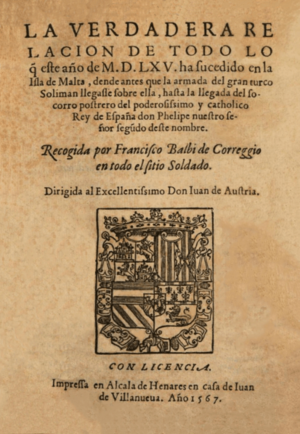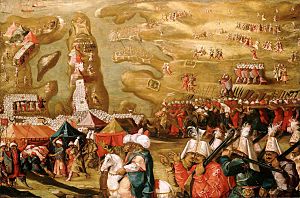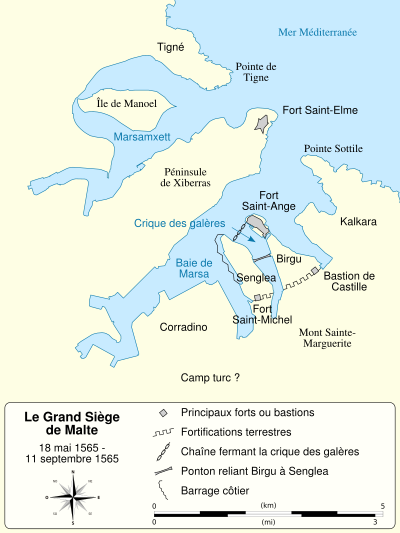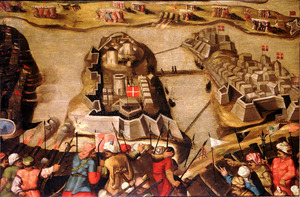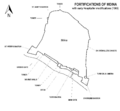Great Siege of Malta facts for kids
Quick facts for kids Great Siege of Malta |
|||||||
|---|---|---|---|---|---|---|---|
| Part of the Ottoman–Habsburg wars | |||||||
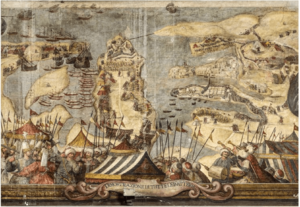 Dimostrazione di tutte le batterie, fresco by Matteo Pérez d'Aleccio at the Grandmaster's Palace in Valletta |
|||||||
|
|||||||
| Belligerents | |||||||
| Commanders and leaders | |||||||
|
|
||||||
| Strength | |||||||
| 35,000–40,000 |
2,500 (6,100, including militia, servants, and galley slaves)
|
||||||
| Casualties and losses | |||||||
| 25,000–35,000 killed in combat and from disease | Unknown | ||||||
The Great Siege of Malta (in Maltese: L-Assedju l-Kbir) happened in 1565. It was a major battle where the powerful Ottoman Empire tried to take over the island of Malta. At that time, Malta was controlled by the Knights Hospitaller, also known as the Knights of Malta.
The siege lasted for almost four months, from May 18 to September 12, 1565. The Knights, along with about 6,000 foot soldiers, managed to defend the island and push back the invaders. This victory was a huge deal in Europe during the 1500s. It showed that the Ottomans, who seemed unbeatable, could be defeated.
This siege was a key moment in the long fight between Christian groups and the Islamic Ottoman Empire for control of the Mediterranean Sea. Other important events included the Ottoman attack on Malta in 1551 and the Battle of Djerba in 1560.
Contents
The Knights of Malta's Journey
The Knights Hospitaller were a military and religious group. In 1522, the Ottoman Sultan Suleiman the Magnificent forced them out of their base on the island of Rhodes. For seven years, the Knights had no permanent home.
In 1530, they became known as the Knights of Malta. This happened when Emperor Charles V gave them control of Malta and Gozo. In return, the Knights had to send one falcon to the Viceroy of Sicily every year and hold a special church service. They also had to protect Tripoli in North Africa, which was a dangerous area controlled by Barbary corsairs, who were allies of the Ottomans. The Knights accepted, even though Malta was a small, quiet island.
The Knights quickly turned Malta into an important naval base. Its location in the middle of the Mediterranean Sea made it a key spot between East and West. This was especially true as the Barbary corsairs became more active in the western Mediterranean.
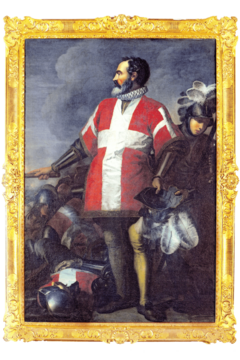
A famous corsair named Dragut was a big threat to Christian nations. Dragut and the Knights often clashed. In 1551, Dragut and Ottoman admiral Sinan tried to take Malta. They invaded with about 10,000 men. After a few days, Dragut stopped the siege and moved to Gozo. There, he attacked the Cittadella. The Knights' governor on Gozo gave up, and the corsairs captured almost everyone (about 5,000 people). Dragut then sailed south and took the Knights' fort in Tripoli.
After this, the Grand Master of the Knights, Juan de Homedes, expected another Ottoman attack. He ordered the defenses of Fort Saint Angelo to be made stronger. He also ordered two new forts to be built: Fort Saint Michael and Fort Saint Elmo. These three forts were built very quickly and became very important during the Great Siege.
Life was calmer for a few years, but the fighting between Muslims and Christians continued. In 1557, Jean Parisot de Valette became the Grand Master. He continued to raid non-Christian ships.
By 1559, Dragut was causing so much trouble that King Philip II of Spain organized a huge naval trip to remove him from Tripoli. The Knights joined this trip, which had about 54 ships and 14,000 men. However, this plan went wrong at the Battle of Djerba in May 1560. Ottoman admiral Piyale Pasha surprised the Christian fleet, sinking or capturing about half their ships. This battle was a disaster for the Christians and showed how strong the Ottomans were in the Mediterranean.
Getting Ready for the Siege
After the Battle of Djerba, it was clear that the Ottomans would attack Malta again. Malta was very important for the Ottoman plan to conquer more of Europe. It was a stepping stone to Sicily, which could then be used to invade Italy.
In August 1560, Jean de Valette told all the Knights to get ready to return to Malta if a summons was sent. The Ottomans made a mistake by not attacking right away, as the Spanish fleet was weak. This five-year delay allowed Spain to rebuild its forces.
Meanwhile, the Knights kept attacking Turkish ships. In 1564, a famous Knight named Mathurin Romegas captured several large merchant ships and important Ottoman officials. These actions gave the Ottomans a reason to attack. By the end of 1564, Sultan Suleiman decided to destroy the Knights of Malta.
By early 1565, Grand Master de Valette's spies in Constantinople (now Istanbul) told him that the invasion was coming soon. De Valette started gathering troops in Italy, stocking up supplies, and finishing work on Fort Saint Angelo, Fort Saint Michael, and Fort Saint Elmo.
Siege Tactics and Weapons
During the siege, all known methods of attacking a fortress were used. The Turkish forces had a huge siege tower with a drawbridge. From this tower, sharpshooters could fire over the walls of Fort St. Angelo. This tower was built to resist fire with wet leather sheets.
However, the Maltese builders had hidden artillery inside the walls, keeping them secret. When the Turks were in the tower, the defenders moved their cannons into place. They fired chain shot (cannonballs linked by a chain) and destroyed the tower.
The Armies Involved
The Turkish fleet, which left Istanbul on March 22, was one of the largest ever seen. According to a historian named Giacomo Bosio, the fleet had 193 ships, including 131 large galleys.
A Spanish soldier named Francisco Balbi di Correggio, who fought in the siege, wrote down the numbers of soldiers:
|
Other reports from the time give slightly different numbers, but most agree that the Ottoman force was much larger than the defenders.
The Siege Begins
Ottoman Arrival and First Moves
Before the Turks arrived, Grand Master de Valette ordered all crops to be harvested, even unripe ones. This was to prevent the enemy from finding food. The Knights also poisoned all the wells with bitter herbs and dead animals.
The Turkish fleet arrived on May 18. They anchored at Marsaxlokk Bay, about 10 kilometers (6.2 miles) from the main harbor. There was a disagreement between the Ottoman land commander, Mustafa Pasha, and the naval commander, Piyale Pasha. Piyale wanted to anchor the fleet closer to the action, but this would mean attacking Fort St. Elmo first. Mustafa wanted to attack the old capital, Mdina, first. In the end, Mustafa agreed to attack Fort St. Elmo, thinking it would only take a few days. This turned out to be a big mistake for the Turks.
While the Ottomans were landing, the Knights and Maltese people quickly improved the defenses of Birgu and Senglea. The Ottomans set up their main camp near the Knights' forts. Attacks on Birgu began on May 21, and on Senglea a day later.
The Fall of Fort St. Elmo
The darkness of the night then became as bright as day, due to the vast quantity of artificial fires. So bright was it indeed that we could see St Elmo quite clearly. The gunners of St Angelo... were able to lay and train their pieces upon the advancing Turks, who were picked out in the light of the fires.
De Valette knew the Turks would try to capture Fort St. Elmo first to protect their fleet. He sent more soldiers and cannons to the fort. He hoped the fort could hold out until help arrived from Sicily. The Ottomans began a heavy bombardment of the fort on May 27. The fort was badly damaged, but de Valette kept sending supplies and taking out the wounded.
On June 3, some Janissaries (elite Ottoman soldiers) managed to take part of the fort's defenses. By June 8, the Knights in St. Elmo sent a message that they couldn't hold on much longer, but de Valette told them they must keep fighting until help came.
The Turks attacked the damaged walls on June 10, 15, and 16. During the all-out assault on June 16, even the slaves and Maltese soldiers fought bravely. Two days later, Dragut, the corsair leader, was killed by a cannonball while inspecting the trenches.
Finally, on June 23, the Turks captured what was left of Fort St. Elmo. They killed all the defenders, over 1,500 men. Only a few Maltese managed to escape by swimming. Even though the Turks took St. Elmo, it cost them at least 6,000 men, including many of their best soldiers. This delay was a critical mistake for the Ottomans.
Fear and a Small Help
News of the siege spread across Europe, causing panic. Many believed that if Malta fell, the rest of Christian Europe would be in great danger. Queen Elizabeth I of England wrote about the serious threat.
Don Garcia, the Viceroy of Sicily, was slow to send the promised help. However, he convinced King Philip II to let him send a small group of about 600 men. This "small relief" (piccolo soccorso) managed to land on Malta in early July and sneak into Birgu. This greatly boosted the spirits of the defenders. However, this force was too small to make a big difference.
Attacks on Senglea and Birgu
On July 15, Mustafa ordered a double attack on the Senglea peninsula. He moved 100 small boats across a hill to the Grand Harbour to attack from the sea. At the same time, corsairs attacked Fort St. Michael from the land. Luckily, a defector warned de Valette about the plan. The Grand Master quickly built a strong fence along Senglea, which helped stop the attack.
The sea attack failed when the Turkish boats came too close to a hidden cannon battery at the base of Fort St. Angelo. Just two shots sank almost all the boats. The land attack also failed, and Malta was saved that day.
The Turks then surrounded Birgu and Senglea with about 65 siege cannons. They heavily bombarded the towns. One historian claims that 130,000 cannonballs were fired during the siege. After destroying part of a main wall, Mustafa ordered another huge attack on August 7 against Fort St. Michael and Birgu. This time, the Turks broke through the town walls. It seemed the siege was over.
However, the invaders suddenly retreated. This happened because a cavalry commander from Mdina, Captain Vincenzo Anastagi, attacked the unprotected Turkish field hospital. The Turks thought that the main Christian relief force had arrived from Sicily and broke off their assault.
Final Attacks and a Clever Trick
After the August 7 attack, the Turks continued to bombard Fort St. Michael and Birgu. They launched another major attack between August 19 and 21. During this intense fighting, Grand Master de Valette himself went to the most dangerous places, inspiring his troops.
The situation was very serious. At one point, the Knights' leaders thought about leaving the town and retreating to Fort St. Angelo. But de Valette refused. He guessed that the Turks were losing their will to fight, and he was right.
Towards the end of August, the Turks tried to take Fort St. Michael again using special siege machines. But Maltese engineers dug tunnels under the rubble and destroyed these machines with cannon fire.
In early September, the weather started to change. Mustafa ordered a march on Mdina, planning to stay there for the winter. However, the attack didn't happen. Mdina was not well-defended, but its cannons started firing at the approaching Turks from a very long distance. This bluff scared the already tired Turks, making them think the city had plenty of ammunition. By September 8, the Turks had loaded their cannons onto ships and were getting ready to leave the island. They had lost about a third of their men to fighting and disease.
The Great Relief Force Arrives
On September 7, Don Garcia finally landed about 8,000 men at St. Paul's Bay on the north side of the island. This "Great Relief" (Grande Soccorso) force waited for the Ottoman attack. When some eager Knights from this force saw the Ottomans retreating and burning villages, they charged without waiting for orders. Seeing their spirit, the commander ordered a general charge. This led to a massacre of the retreating Ottoman forces. The Ottomans left the island completely on September 13.
Malta had survived the Ottoman attack. Across Europe, people celebrated this victory, which was one of the last big battles involving Crusader Knights. The relief force included soldiers from Spain, Italy, Florence, Genoa, the Papal States, and Savoy.
Aftermath and Legacy

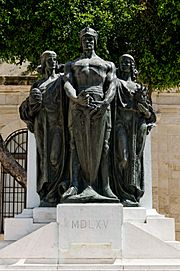
The exact number of deaths is debated, but many thousands of Turkish soldiers died. The Knights lost about a third of their men, and Malta lost a third of its people. The towns of Birgu and Senglea were almost completely destroyed. Still, about 9,000 defenders had held out for over four months in the hot summer, even with 130,000 cannonballs fired at them.
Jean de Valette, the Grand Master, was key to the victory. His leadership and ability to inspire people were very important. This victory encouraged European kings to form an alliance against the Ottomans. This led to the huge Battle of Lepanto six years later, where the Ottomans were decisively defeated.
Europe was so grateful for the Knights' heroic defense that money poured into Malta. De Valette used this money to build a new, strong city called Valletta on Mount Sciberras. He wanted to make sure no enemy could use that position again. De Valette himself died in 1568.
See also
 In Spanish: Sitio de Malta (1565) para niños
In Spanish: Sitio de Malta (1565) para niños
- Algiers expedition (1541)
- Barbary corsairs
- Battle of Djerba
- Battle of Lepanto
- Battle of Preveza
- List of Ottoman sieges and landings
- List of sieges
- Siege of Rhodes (1480)
- Siege of Rhodes (1522)
- Toni Bajada
- Grand Harbour of Malta tornado
Images for kids
-
View of Mdina (above) and map of the city's fortifications as they were in 1565 (below)




